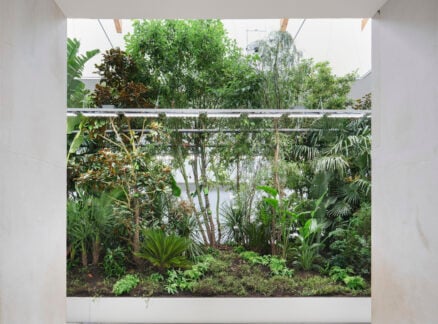
October 5, 2020
Lime Continues to Find Applications in Architecture
From the Roman Pantheon to contemporary homes and low-carbon concrete, lime offers brightness and durability.
Surfaces of all kinds are top of mind these days, so we decided to look at all aspects of them, in these articles, from A to Z. Thinking of surfaces less as a product category and more as a framework, we use them as a lens for understanding the designed environment. Surfaces are sites of materials innovation, outlets for technology and science, and embodiments of standards around health and sustainability, as well as a medium for artists and researchers to explore political questions.

In Dénia, a coastal city in the Alicante province of Spain, the architect Carles Faus Borràs designed a modern country house—a rectilinear, two-story volume that blurs the boundary between indoors and out in the balmy Mediterranean climate. A large outdoor terrace, facing a pool, frames an opening into the double-height living space. But the stacked structure’s uniform color palette is what gives it its monumentality. The project is “a large white canvas,” says the architect. “White is a generator and driver of light.” The muted, uniform facade is made from a lime aggregate that wraps the reinforced concrete structure like stucco and protects it. Lime mortar is a typical facade coating in the area because of its homogeneous texture and color and resistance to cracking as the structure settles.
A versatile mineral, lime has been used in construction since antiquity. It’s believed that the Roman Pantheon’s 142-foot-high dome still stands because its mortar contains a blend of limestone and volcanic ash, creating a bond that helped deter cracks from forming. But, although lime is fired at a lower temperature than concrete and therefore requires less fuel, its use today in building construction—at least in the U.S.—is limited.
Norman R. Weiss, a professor at Columbia University’s Graduate School of Architecture, Planning and Preservation and an analytical chemist who has worked with historic structures for more than 50 years, believes this is in part due to the proliferation of the companies that manufacture Portland cement, which dries faster and is easier to apply. He also says that lime finishes are less durable than cement stuccos when they come into contact with acid rain, snow, and gases, as they do in big cities. That hasn’t deterred Weiss from spending the last ten years developing a lime-pozzolan blend, a mortar he and others inject into historic stone buildings to prevent and repair cracks. Weiss has also been developing a lime concrete with a lightweight aggregate to create collar joints in masonry walls. While he receives enthusiastic responses to broadening his products’ applications, he doesn’t see lime concrete wall panels happening anytime soon, he says.
You may also enjoy “Ahree Lee Highlights How Women Pioneered Weaving and Early Computing.”
Would you like to comment on this article? Send your thoughts to: [email protected]
Register here for Metropolis Webinars
Connect with experts and design leaders on the most important conversations of the day.
Recent Viewpoints
Viewpoints
Sustainability News Updates for Q2 2025










